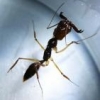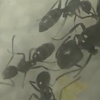And, on how to mate ants, here is a snippet I found from the AntWiki .... seems pretty brutal though:
Reproductive forms can be easily reared in the laboratory, but those of most species cannot be induced to mate under the culturing conditions ordinarily employed. The reason is that the virgin queens and males must engage in extensive nuptial flights under an exacting regimen of temperature and humidity before they will copulate. However, the rule is not absolute. A few polygynous species mate in or close to the nest, so that laboratory colonies can be maintained and multiplied indefinitely. Examples include pharaoh's ant Monomorium pharaonis (see Peacocke and Baxter, 1950, and Berndt and Eichler, 1987), a species of []Solenopsis (Diplorhoptrum) from Ecuador we have had in culture for over twelve years, Xenomyrmex floridanus (Hölldobler, 1971d), several species of Cardiocondyla (Robin Stuart, personal communication), the slavemaking myrmicine Harpagoxenus sublaevis and many other parasitic ants (Buschinger, 1972b, 1976a), the Argentine ant Iridomyrmex humilis (Smith, 1936a), and Paratrechina longicornis. Within these species it is possible to make careful studies of reproductive behavior, including the bioassaying of sex pheromones. In fact Karl Gösswald and his co-workers exploited this form of mating behavior to mass-produce queens. Colonies were then started in forests, where the workers protect the trees against pest insects (see Plate 4).
Buschinger (1975a) has furthermore gone so far as to conduct a genetic analysis by breeding experiments in the case of the ergatogynic locus of Harpagoxenus sublaevis, but in general such studies are handicapped by the relatively long time (sometimes several years) to rear a mature colony from a newly inseminated queen. It is likely that future genetic studies will depend a great deal on electrophoretic separation of enzymes and amino acid and nucleotide sequencing.
The nuptial flight could conceivably be short-circuited and fertile queens produced if queens were readily inseminated. This has been achieved in the case of the fire ant Solenopsis invicta by Cupp et al. (1973). These authors kept reproductive forms in a warm (32°C), humid environment with an 18-hour photoperiod. They decapitated the male (an action that disinhibits copulatory movements), pinned it through the thorax, and set it in a parafilm mount with the abdomen pointing upward. The female was anesthetized with carbon dioxide. Her wings were grasped with jeweler's forceps and her abdomen stroked against the body in a front-to-rear motion until copulation occurred. Genetic analysis by breeding experiments could be greatly accelerated if artificial insemination were combined with precocious production of sexual forms through the treatment of young colonies with appropriate levels of disinhibitors or juvenile hormone. This technology, however, remains to be proven.




















